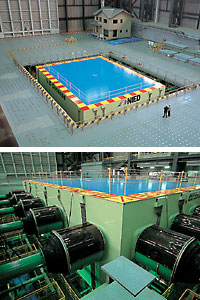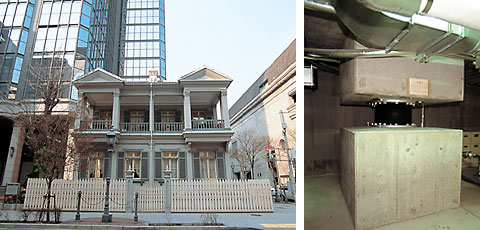| Web Japan > NIPPONIA No.33 > Special Feature* |
|
|
|
NIPPONIA No.33 June 15, 2005 |
|
Special Feature*
Earthquake simulator shakes buildings as tall as six stories
E-Defense
The 3D Full-Scale Earthquake Testing Facility (called E-Defense for short) was completed in April 2005, a decade after the Great Hanshin Awaji Earthquake flattened parts of the Kobe region. The new facility is located in Miki, Hyogo Prefecture, not far from Kobe, and was constructed by the National Research Institute for Earth Science and Disaster Prevention. It has a concrete slab that simulates strong jolts and can shake buildings as tall as six stories.
The earthquake that rocked the Kobe region collapsed many buildings, killing thousands of people. E-Defense was developed in the hope that it would help prevent more deaths after such a disaster. The concrete slab shakes actual-size test buildings and monitors the processes leading to their weakening and collapsing. The tests provide information that will be used to design quake-resistant buildings and test those designs.
The large concrete slab simulates earthquakes as severe as the magnitude-7 one that rocked the Kobe region in 1995, and produces three-dimensional movements — vertical, side-to-side, and back-and forth — that cause the building to collapse.
|
|
Kobe's oldest Western-style building now stands on shock-absorbing material
House No. 15 of the old foreign settlement
Japan's residential construction industry is developing its own quake-resistant and shock-absorbing techniques to keep buildings standing after a major earthquake.
House No. 15, located in what is now Chuo Ward in Kobe, was the oldest Western-style wooden building in Kobe's former foreign settlement until the Great Hanshin Awaji Earthquake flattened it in 1995. A movement to bring the house back to its old glory was successful, and reconstruction began with the placing of shock-absorbing rubber pads under four pillars that now support the entire structure.
Today the building is used as a resaurant. If you ask a staff member, they will take you into the basement to see the shock-absorbing construction method, complete with rubber pads.
|
|
||||||
|
||||||
|

